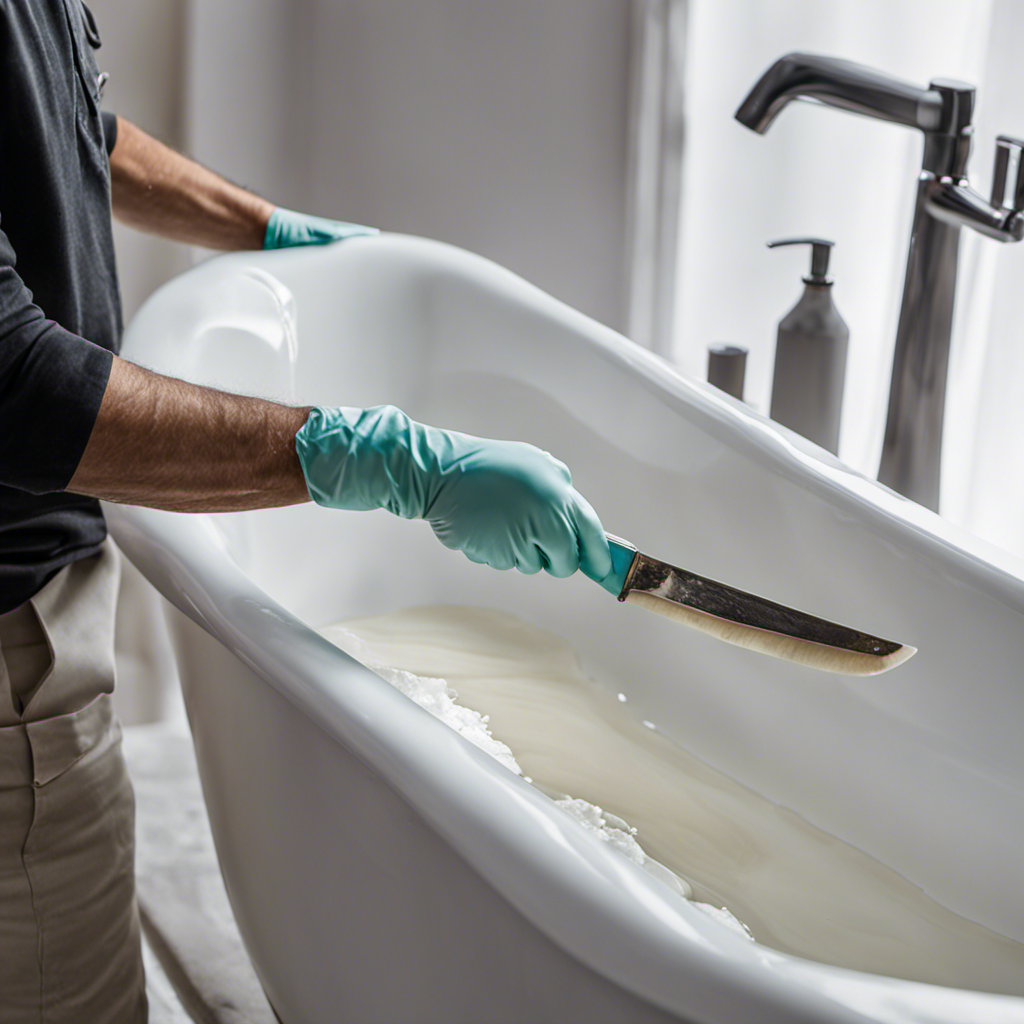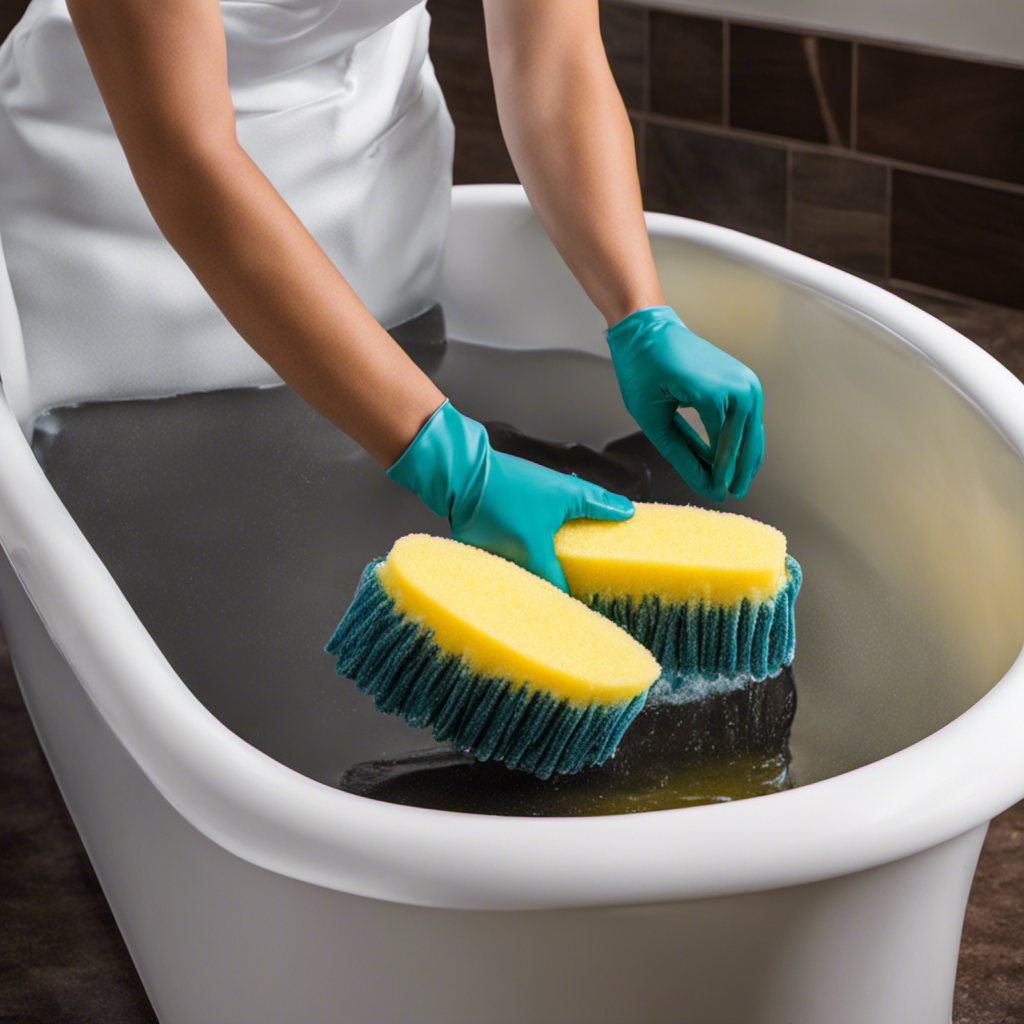Are you tired of staring at that unsightly stained bathtub every time you step into your bathroom? Don’t fret, because we’ve got you covered!
In this article, we will guide you through the process of cleaning your stained bathtub, leaving it sparkling and fresh.
From understanding the different types of bathtub stains to using the right cleaning supplies and techniques, we’ll equip you with all the knowledge you need to transform your bathtub into a pristine oasis.
So grab your gloves and get ready to say goodbye to those stubborn stains!
Key Takeaways
- Different types of bathtubs are prone to different types of stains, such as rust stains in porcelain bathtubs and hard water stains in acrylic and fiberglass tubs.
- Gather the necessary cleaning supplies, including a cleaning solution designed for bathtub stains, a scrub brush suitable for different surfaces, a microfiber cloth, gloves, and a bucket.
- Prepare the bathtub for cleaning by choosing the right cleaning products, removing any items or accessories, and ensuring proper airflow with open windows or ventilation.
- Use natural cleaners like vinegar, baking soda, and lemon juice to effectively clean bathtub stains, and consider professional stain removal services if needed. Additionally, prevent future stains by regularly cleaning and drying affected areas and minimizing mineral buildup.
Understanding the Different Types of Bathtub Stains
To understand the different types of bathtub stains, you’ll need to identify the cause of the discoloration. Different types of bathtub materials can be prone to different types of stains. For example, porcelain bathtubs are susceptible to rust stains, while acrylic and fiberglass tubs may develop hard water stains.
Soap scum and mineral deposits are also common causes of bathtub stains, regardless of the material. Soap scum can build up over time, leaving a greasy film and discoloration. Mineral deposits, on the other hand, occur when hard water evaporates, leaving behind a residue.
Understanding the specific type of stain on your bathtub will help you choose the most effective cleaning method. With this knowledge, you can now move on to gathering the necessary cleaning supplies to tackle those stubborn stains.
Gathering the Necessary Cleaning Supplies
You’ll need a few supplies to get started on tackling those stubborn bathtub stains. Here’s a list of three essential items you’ll need:
-
Cleaning solution: Look for a cleaning product specifically designed for removing different types of bathtub stains. These solutions are usually formulated to target common causes of stains in bathtubs, such as soap scum, hard water deposits, and mold/mildew.
-
Scrub brush: To effectively remove stains, you’ll need a good scrub brush with sturdy bristles. Look for one that is suitable for use on different types of bathtub surfaces, such as porcelain, acrylic, or fiberglass.
-
Microfiber cloth: After scrubbing the stains, you’ll want to wipe away any residue or cleaning solution. A microfiber cloth is perfect for this task, as it is gentle on the surface and highly absorbent.
Preparing the Bathtub for Cleaning
When it comes to cleaning your bathtub and removing tough stains, it’s important to choose the right cleaning products. You want to use products that are specifically designed for removing soap scum, hard water stains, and grime.
Look for cleaners that contain ingredients like bleach, hydrogen peroxide, or citric acid, as these can effectively break down and remove stubborn stains.
Additionally, consider using a scrub brush or sponge with abrasive bristles to help scrub away tough stains and grime.
Cleaning Products to Use
For the best results, use a strong cleaner to tackle those stubborn stains in your bathtub. When it comes to cleaning your bathtub, using natural cleaners can be an effective and safer alternative to harsh chemicals.
Here are three natural cleaners that can help you remove grime effectively:
-
Vinegar: Mix equal parts of white vinegar and water in a spray bottle. Spray the mixture onto the stained areas and let it sit for a few minutes. Scrub with a sponge or brush, then rinse thoroughly.
-
Baking soda: Create a paste by mixing baking soda with a small amount of water. Apply the paste to the stains and gently scrub with a sponge or brush. Rinse well to reveal a clean surface.
-
Lemon juice: Cut a lemon in half and sprinkle salt onto the cut side. Rub the lemon directly onto the stains, applying pressure to loosen the grime. Rinse thoroughly afterwards.
Using natural cleaners not only helps remove grime effectively, but also ensures a safer and healthier environment for you and your family.
Now, let’s move on to the next section and learn how to remove tough stains from your bathtub.
Removing Tough Stains
To effectively remove tough stains, try using a mixture of vinegar and baking soda in a spray bottle. This combination is a powerful natural cleaning solution that can tackle even the most stubborn stains on your bathtub.
Simply spray the mixture onto the stained area and let it sit for a few minutes. Then, scrub the stain with a brush or sponge, paying extra attention to the areas where the stain is particularly stubborn. Rinse the area thoroughly with water to remove any residue.
If the stain persists, you may want to consider professional stain removal services. These professionals have access to specialized products and techniques that can effectively remove tough stains from your bathtub.
Now, let’s move on to the next section and learn about removing soap scum buildup.
Removing Soap Scum Buildup
You can easily remove soap scum buildup by using a mixture of vinegar and baking soda. Soap scum is a common problem in bathrooms and can make your bathtub look dirty and unappealing. Here’s how to tackle it:
- Mix equal parts vinegar and baking soda in a bowl to create a paste.
- Apply the paste to the soap scum using a sponge or cloth.
- Scrub the scum in circular motions, focusing on the areas with the most buildup.
The vinegar helps to dissolve the soap scum while the baking soda acts as a gentle abrasive to scrub it away. Once you’ve scrubbed the entire surface, rinse it thoroughly with warm water.
This method is effective in removing soap scum and also helps in preventing future buildup.
Treating Hard Water Stains
If you’re struggling with hard water stains, there are a few key points to keep in mind.
First, vinegar is an effective and natural stain remover that can help break down and remove hard water deposits. You can simply mix equal parts vinegar and water, apply it to the stained area, let it sit for a few minutes, and then scrub it away.
Second, preventing future hard water stains is important to maintain the cleanliness of your surfaces. Regularly cleaning and drying the affected areas, using a water softener, or installing a water filtration system can help minimize the buildup of minerals and prevent future stains.
Vinegar as Stain Remover
Using vinegar is an effective way to remove stains from your bathtub. Vinegar, a natural cleaner, is a popular DIY bathtub stain remover. Here are three reasons why vinegar should be your go-to solution for removing stains:
-
Versatility: Vinegar can tackle various types of stains, including hard water stains, soap scum, and mineral deposits. Its acidic properties help break down and dissolve these stubborn stains.
-
Cost-effective: Compared to commercial cleaners, vinegar is a budget-friendly option. You can easily find it in your kitchen pantry, making it a convenient and affordable solution for stain removal.
-
Environmentally friendly: Vinegar is a non-toxic and eco-friendly alternative to harsh chemicals. By using vinegar, you are promoting a greener and healthier cleaning routine for yourself and the environment.
Preventing Future Hard Water Stains
To avoid future hard water stains, it’s important to regularly maintain the cleanliness of your bathtub. Preventing mineral deposits is key to keeping your tub looking pristine.
One of the best cleaning techniques is to wipe down your bathtub after each use. This simple step can help remove any residue or minerals that may have accumulated. Additionally, using a squeegee or towel to dry the tub thoroughly can prevent water spots and mineral buildup.
Another effective method is to use a mild acidic cleaner, such as white vinegar or lemon juice, to dissolve any mineral deposits that may form. Regularly scrubbing your bathtub with a non-abrasive cleaner can also help prevent stubborn stains.
Tackling Rust and Iron Stains
You’ll need a rust remover to effectively tackle those stubborn iron stains in your bathtub. Rust stains can be unsightly and difficult to remove, but with the right products and techniques, you can restore your bathtub to its former glory.
Here’s what you need to do:
-
Choose a rust remover: Look for a rust remover specifically designed for bathroom surfaces. These products are formulated to break down rust and remove it without damaging your bathtub.
-
Apply the rust remover: Follow the instructions on the product and apply the rust remover to the stained areas. Allow it to sit for the recommended amount of time to penetrate the rust.
-
Scrub and rinse: Use a non-abrasive sponge or brush to gently scrub the stained areas. Rinse thoroughly with water to remove the rust remover and any remaining stains.
To prevent future iron stains, consider installing a water softener to reduce the mineral content in your water. Regularly clean and dry your bathtub to prevent the buildup of minerals and rust.
Dealing With Mold and Mildew
When it comes to dealing with mold and mildew, it’s important to take preventive measures to keep them from spreading and causing further damage.
One effective method is to control moisture levels in your home by using dehumidifiers and ensuring proper ventilation.
Additionally, regularly cleaning and drying areas prone to mold growth, such as bathrooms and basements, can help prevent the problem from escalating.
Prevention Tips for Mold
Regularly cleaning your bathroom and ensuring proper ventilation can help prevent mold growth in your bathtub. To effectively prevent mold in your bathroom, here are some tips to keep in mind:
-
Keep the bathroom well-ventilated: Open windows or use an exhaust fan during and after showers to reduce humidity levels.
-
Clean and dry surfaces regularly: Wipe down the bathtub, tiles, and shower curtains after each use to prevent moisture buildup.
-
Use mold-resistant materials: Opt for mold-resistant paint, caulk, and grout to minimize the chances of mold growth.
By following these effective mold prevention techniques and implementing these tips for keeping your bathroom mold-free, you can significantly reduce the risk of mold growth in your bathtub.
Now, let’s move on to discussing effective cleaning methods to remove stains from your bathtub.
Effective Cleaning Methods
To keep your bathroom free of stains, it’s important to regularly maintain cleanliness using effective cleaning methods.
When it comes to cleaning your bathtub, there are a few techniques that can help you achieve a spotless result.
Start by applying a mixture of baking soda and water to the stained areas. Let it sit for a few minutes to loosen the grime. Then, scrub the surface using a soft brush or sponge.
For tough stains, you can use a commercial cleaner specifically designed for bathtubs. Remember to follow the instructions on the product and rinse thoroughly afterwards.
To maintain a clean bathtub, it’s also important to wipe it down regularly with a mild cleaner and a soft cloth.
Removing Stubborn Stains With Baking Soda and Vinegar
You can easily remove stubborn stains from your bathtub by using a mixture of baking soda and vinegar. Here’s how:
-
Create a paste by mixing equal parts baking soda and water. Apply the paste to the stained areas and let it sit for about 15 minutes.
-
In a spray bottle, mix equal parts vinegar and water. Spray the mixture over the baking soda paste and let it fizz for a few minutes.
-
Scrub the stained areas with a sponge or scrub brush, focusing on the toughest spots. Rinse thoroughly with water.
This cleaning hack is a great alternative to harsh chemical cleaners and is effective in removing stains without damaging the surface of your bathtub. Baking soda acts as a gentle abrasive, while vinegar helps to break down and dissolve the stains.
Give it a try and enjoy your sparkling clean bathtub!
Using Commercial Cleaners for Tough Stains
If you’re dealing with tough stains, consider using commercial cleaners for a more effective solution. While using natural alternatives and homemade stain removers can be great for regular cleaning, sometimes they may not be strong enough to tackle stubborn stains in your bathtub.
Commercial cleaners are specifically formulated to break down and remove tough stains, making them a reliable option when all else fails. These cleaners often contain powerful ingredients such as bleach, hydrogen peroxide, or abrasive particles that can effectively lift and dissolve deep-set stains.
They are designed to target specific types of stains, like rust or soap scum, and can provide quicker and more noticeable results. However, it’s important to read and follow the instructions carefully, as some commercial cleaners may contain harsh chemicals that require proper ventilation and protective gear during use.
Maintaining a Clean and Stain-Free Bathtub
Regular maintenance is essential to keep your bathtub free from dirt and discoloration. By following these simple steps, you can prevent soap scum buildup and maintain the shine of your bathtub:
-
Clean regularly: Wipe down your bathtub after each use to remove any soap residue or dirt. This will prevent the buildup of soap scum and keep your bathtub looking clean and shiny.
-
Use a mild cleaner: When cleaning your bathtub, avoid harsh chemicals that can damage the surface. Instead, opt for a mild cleaner specifically designed for bathtubs. This will effectively remove any stains or grime without causing any harm.
-
Rinse thoroughly: After cleaning your bathtub, make sure to rinse it thoroughly with warm water. This will remove any leftover cleaner and prevent any residue from building up.
Frequently Asked Questions
How Long Does It Take for the Cleaning Solution to Work on Soap Scum Buildup?
To remove stubborn stains from your bathtub and avoid using chemical cleaning solutions, try natural alternatives like baking soda and vinegar. The effectiveness of the cleaning solution on soap scum buildup may vary depending on the severity of the stains.
Can I Use Bleach to Remove Hard Water Stains From My Bathtub?
You can use bleach alternatives to remove hard water stains from your bathtub. Homemade bathtub cleaners are effective and safe options. Start by discussing the Current Question without the context of: How to Clean Stained Bathtub.
Is It Safe to Use Baking Soda and Vinegar on a Bathtub With a Non-Slip Surface?
Using baking soda and vinegar is safe for cleaning your non-slip bathtub. These alternative cleaning methods are effective in removing stains and dirt. Apply the mixture, scrub gently, and rinse thoroughly for best results.
What Is the Best Way to Prevent Rust and Iron Stains From Forming in the Bathtub?
To prevent rust stains and remove iron stains from your bathtub, there are a few effective methods. Regularly cleaning and drying the tub, using a rust inhibitor, or applying a protective coating can help keep it stain-free.
How Often Should I Clean My Bathtub to Maintain a Stain-Free Surface?
To maintain a spotless surface, clean your bathtub regularly for optimal hygiene. The frequency depends on your usage, but aim for at least once a week. Use the best cleaning products for removing stubborn stains.
Conclusion
In conclusion, cleaning a stained bathtub may seem like a daunting task, but it can be easily tackled with the right knowledge and supplies. Remember the old adage, ‘A stitch in time saves nine,’ and make sure to regularly maintain and clean your bathtub to prevent stubborn stains from building up.
By understanding the different types of stains and using the appropriate cleaning methods, such as baking soda and vinegar or commercial cleaners, you can keep your bathtub looking fresh and stain-free for years to come.
Happy cleaning!










